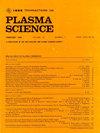An Analytical and Mode Mapping Approach Using Machine Learning for Optimizing Hybrid Material-Based THz Antenna With Surface Plasmon Polaritons
IF 1.3
4区 物理与天体物理
Q3 PHYSICS, FLUIDS & PLASMAS
引用次数: 0
Abstract
This article proposes two complementary Yagi-Uda antenna configurations based on hybrid metal-graphene materials with the exploration of surface plasmon polariton (SPP) mechanism for enhanced performance at the THz regime. These antennas are compared with the estimated outcomes in terms of impedance matching, directivity, radiation pattern, and front-to-back ratio. The SPP mechanism plays a crucial role in optimizing the performance by influencing the dispersion properties and mode propagation. The antenna configurations provide −10-dB impedance bandwidths of 10.59% (2.87–3.19 THz) and 22.95% (2.7–3.4 THz). The maximum achieved gain and efficiency are 7.8 dBi and 84.43%, respectively. The performance of the antenna is validated using analytical optimization at the THz regime, incorporating plasma frequency and collision frequency effects. In addition, the equivalent circuit model is analyzed and explored using advanced system design (ADS) to compare the antenna performance with conventional approaches. Moreover, this work provides a significant analysis of modes pertaining to the radiating elements, which efficiently predict the far-field characteristics of the antenna. The existence of higher order modes TM24 and TM44 is analyzed. To address the existence of these modes, a machine learning (ML) technique based on a convolutional neural network (CNN) model is adopted for mode mapping, involving data cleaning, feature extraction, and normalization. Thus, the performance of the antenna is rigorously validated by employing both analytical and ML approaches, with the exploration of SPP mechanism in hybrid material-based nanoantennas at the THz regime.利用机器学习的分析和模式映射方法优化具有表面等离子体极性子的混合材料型太赫兹天线
本文提出了基于混合金属-石墨烯材料的两种互补的Yagi-Uda天线结构,并探索了表面等离子激元(SPP)机制,以增强太赫兹波段的性能。将这些天线与估计结果在阻抗匹配、指向性、辐射方向图和前后比方面进行比较。SPP机制通过影响色散特性和模式传播对优化性能起着至关重要的作用。天线配置提供−10db阻抗带宽10.59% (2.87-3.19 THz)和22.95% (2.7-3.4 THz)。最大增益和效率分别为7.8 dBi和84.43%。在太赫兹波段,结合等离子体频率和碰撞频率效应,对天线的性能进行了分析优化验证。此外,利用先进系统设计(ADS)对等效电路模型进行了分析和探索,并与传统方法进行了性能比较。此外,本工作提供了与辐射元件有关的模式的重要分析,有效地预测了天线的远场特性。分析了高阶模TM24和TM44的存在性。为了解决这些模式的存在,采用基于卷积神经网络(CNN)模型的机器学习(ML)技术进行模式映射,包括数据清洗、特征提取和归一化。因此,采用分析和ML方法严格验证了天线的性能,并探索了基于混合材料的纳米天线在太赫兹波段的SPP机制。
本文章由计算机程序翻译,如有差异,请以英文原文为准。
求助全文
约1分钟内获得全文
求助全文
来源期刊

IEEE Transactions on Plasma Science
物理-物理:流体与等离子体
CiteScore
3.00
自引率
20.00%
发文量
538
审稿时长
3.8 months
期刊介绍:
The scope covers all aspects of the theory and application of plasma science. It includes the following areas: magnetohydrodynamics; thermionics and plasma diodes; basic plasma phenomena; gaseous electronics; microwave/plasma interaction; electron, ion, and plasma sources; space plasmas; intense electron and ion beams; laser-plasma interactions; plasma diagnostics; plasma chemistry and processing; solid-state plasmas; plasma heating; plasma for controlled fusion research; high energy density plasmas; industrial/commercial applications of plasma physics; plasma waves and instabilities; and high power microwave and submillimeter wave generation.
 求助内容:
求助内容: 应助结果提醒方式:
应助结果提醒方式:


